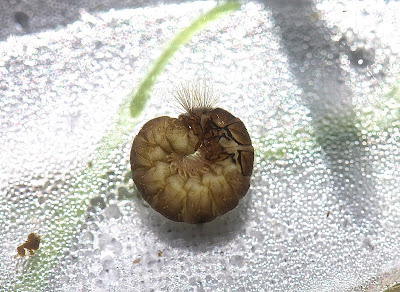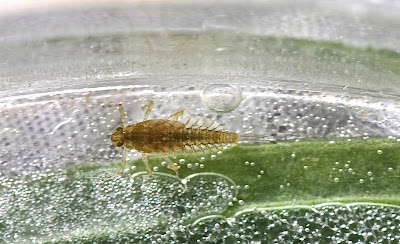I was looking for a particular insect this morning, and I found it shortly after I entered the stream -- the small minnow mayfly Acentrella nadineae. Actually, with the exception of a single B. intercalaris, it's the only Baetid I saw, and it was around in significant numbers.
This is my favorite small minnow mayfly because of its spectacular colors. The splashes of orange and red on the abdomen and the thorax are used for species ID, as are the unusual gills: "gills elongate, asymmetrical, and with basomedial pigmentation splotches." (Beaty, "The Ephemeroptera of North Carolina," p. 4) The oranges and reds are often muted on mature nymphs (see the second nymph pictured below -- the one with black wing pads), but the gills never change. They're a dead give-away.
No question about it, the "splotches" of pigmentation do indeed run from the base of each gill to the middle. And they are splotches!
A. nadineae was identified as a new species of small minnow mayfly in 2009 by McCafferty, Waltz, and Webb. They noted that it had been found in southern and eastern Ohio and parts of North Carolina. As I noted in my entry of 8/6/11, it's clearly in parts of Virginia as well: I've found it at the Lynch River, the Rapidan River, Buck Mt. Creek, the Doyles River, and Powells Creek, and I have no doubt that it's elsewhere as well. With a TV of 1.9, it's relatively intolerant.
It's a beautiful insect -- but it's not easy to get a good photo of this one. The nymphs never want to pause to pose. So, of the 150 photos that I took this morning, I had 5 or 6 with which I was pleased. Here you go.
In this photo, we have both a female and male (upper left, lower right). As with most (all?) small minnow mayflies, the females are bigger than the males (6 mm vs. 5 mm).
And then there was this one, lonely, male Baetis intercalaris.
________________
While I've paid them little attention so far, the common netspinners are also appearing in force. I took some photos of this Ceratopsyche alhedra this morning.
Oh. The netspinner I found at the Doyles -- cream-colored body, light brown head -- was Ceratopsyche sparna. Should have known that.
_______________
And here is the nice set of riffles where I was looking this morning.



















































